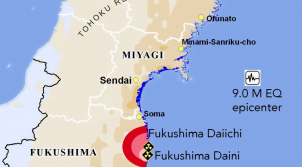The latest update from the UN Office for the Coordination of Humanitarian Affairs contains new information on the casulties, destruction and international response to the earthquake and tsunami.
Casualties
The number of casualties continues to rise. The Government has now confirmed 5,178 people have died and another 2,285 are injured. The number of people who are missing has increased to 8,913 from 7,844.
Tokyo Evacuations
The Embassy of Germany in Japan have instructed their nationals residing in Tokyo and Yokohama to evacuate either to the western part of Japan or outside the country. The Embassy has also transferred some of their operations to Osaka. The British, Australian and French embassies have given similar instructions to their nationals. Australia has moved their embassy to its Honorary Consulate in Osaka. The Embassies of Iraq, Bahrain and Angola have temporarily closed their embassies. According to 2007 data from the Japan Statistics Bureau, there are about 2.1 million foreign residents living in Japan, with the majority from China, Korea, Brazil and the Philippines. The Tokyo Regional Immigration Bureau says that approximately 10,000 foreign nationals have left (or are leaving the country).
International Assistance:
The Government of Japan has requested its position on international donations of relief items and on international Non-Governmental Organizations (NGOs) operating in Japan be made public. With regard to relief items, “the Government of Japan has received offers for relief goods/material from many countries, international organizations, NGOs and private sector. The Government is identifying the needs and establishing a mechanism for storage and transportation to affected people. Therefore, it is recommended not to send any relief goods without coordination with the Government and local governments”.
Concerning NGOs, the Government of Japan says “Search and Rescue operation phase still continues in the affected areas at this moment and the access to those areas is strictly limited to rescue workers. It is also reported that there is temporary shortage of petrol in the affected area. International/foreign NGOs are recommended to wait until the situation improves so that those NGOs are able to conduct their activities in a self-sustainable way”.
It is understood that some 13 NGOs are providing assistance in the tsunami and earthquake affected areas, working through local partners. Medecins Sans Frontieres (MSF) has a team of 10 people divided into three groups, conducting mobile clinics and assessments in Miyagi prefecture. Turkish Red Crescent, Switzerland Humanitarian Aid Response Team, Save the children, and Plan International have deployed technical assistance teams in the affected region.
U.S. Military Response:
Currently nearly 5300 U.S. service man and women are supporting the disaster relief effort in Japan. The military operation includes eight ships, including the aircraft carrier USS Ronald Reagan, transport aircraft and more than 100 military helicopters which are being repositioned to northern Japan to best assist ongoing humanitarian efforts. The U.S. military has flown reconnaissance flights and provided the Japanese government with images of the areas affected by the earthquake and tsunami. Search and rescue flights and missions along the coast continue, relief operations including the delivery of food, water and other relief supplies also continue.
